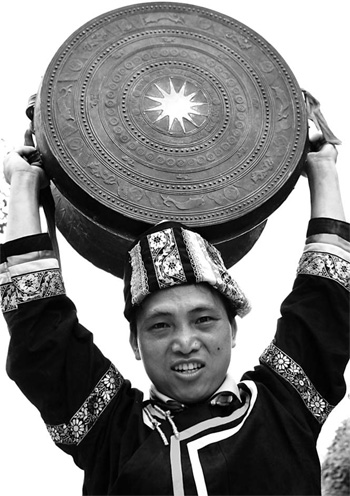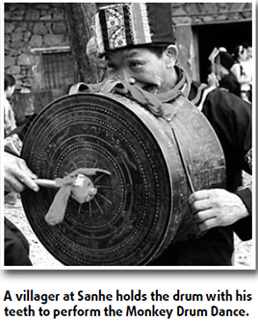 |
|
Bronze drum is a crucial musical instrument for villagers of Sanhe village, Donglan county, Guangxi Zhuang autonomous region. [Huo Yan] |
Two muscle-bound men lift a 17 kg bronze drum with their teeth amid a thunderous beating sound. Amazingly, the young men can still dance in rhythm as they bite on the 50-cm diameter metal drum.
Performers Meng Shengwen and Song Zhongze say they have been learning this dance from old masters at the Sanhe village in northwestern Guangxi Zhuang autonomous region since the age of 12.
Meng says in order to lift the bronze drum with his teeth he needs to chant a mysterious incantation. Only four people in the village have succeeded in this feat, he says.
Villagers at Sanhe belong to the Bunu, a small branch of Yao minority who live in southern China.
The Monkey Drum Dance they perform at the annual summer Zhuzhu Festival is a harvest-time celebration and tells the story of how ancient people fended off wild monkeys and protected the crops.
Village head Lan Shanglin says the dance is staged to commemorate a legendary hero known as Jiudai Wang (King of the 9th Generation), who fought off the wild monkeys, bringing peace to his people as they struggled to live in the remote mountains.
The drum is one of the oldest musical instruments in the world and has been used in every continent by every people throughout the ages.
The bronze drum is especially old and it is estimated there are only some 2,400 ancient bronze drums still existing.
Donglan county of Hechi city, Guangxi, boasts 613 such precious drums.
The unique folk customs relating to the bronze drums have gained the city much fame and the Cultural Ministry is planning to apply to the UNESCO to list the bronze drum folk customs in Guangxi as an intangible cultural heritage that needs urgent protection.
Besides the villagers at Sanhe who still perform ancient dances with the bronze drum, more people have devoted themselves to the preservation of this ancient instrument.
Wei Wanyi, 83, has been collecting bronze drums for some 30 years. His apartment in Donglan is packed with drums of various sizes and pictures of the instrument cover the walls. Among the 24 big drums in his collection, Wei favors one particular instrument the most.
Weighing 3.80 kg and measuring 23.40 cm in diameter, the drum cost Wei the enormous price of 5,000 yuan ($730) in 1976.
Wei says it is "the only one of its kind" because of its rare shape and strange decoration patterns. He believes it is almost 2,000 years old and dates back to the early Eastern Han Dynasty (AD 25-220).
The old man has four drums passed down to him by his ancestors. Wei says two drums might have been made before the Yuan Dynasty (1271-1368) while the other two may have been created during the Ming or Qing dynasties (1368-1911).
Tone, quality of the bronze and decorative patterns are the three criteria which make up a good drum, Wei says.
The best bronze drums appear crimson and are perfect in shape and more important, a superior drum must be able to produce all seven musical notes.
As for the patterns, Wei says people from different areas have different favorites.
In the villages west of the Hongshui River, the pattern of two dragons, which symbolizes longevity, is popular; while people east of the river are attracted to the 12 Chinese zodiac animals because they believe animals and humans are good friends.
Wei has seen nearly all of the 600 bronze drums collected by people in Donglan and has been writing a book on the history of bronze drums.
He also hopes one day to establish a museum, which highlights this ancient instrument.
The expert says drums had their practical uses too. They were used to store crops or water before villagers gathered and used them musically as they celebrated special events. During war, people also beat drums to send out a warning.
As the living standards improved, few locals made bronze drums. But in recent years, people realized the cultural value of the drums and more collectors are hunting for genuine ancient drums in the county.
The growing interest has led to the revival in drum production.
At Jixiang village of Donglan county, Luo Mingjin has spent four years making bronze drums carefully following ancient rules.
Luo and four staff toil in a 100 sq m studio in a valley and use no machines as they make wooden molds, cast and polish.
In the absence of a manual, Luo learned from local folk masters such as Luo Kaixian, 74, who was born into a family of drum makers.
It took Luo Mingjin two years to finally grasp the techniques of making good drums in terms of shape and sound.
He has sold some 100 drums in the past two years. The largest one, 1.2 m in diameter and ordered by a tourism company in Shandong province, brought him 50,000 yuan ($7,320). The average drums with a half-meter diameter sell for about 3,000 yuan, Luo says.
If customers order drums as musical instruments, Luo says more copper is needed to produce better sound. But most customers want the drums as decorations.
The local government is planning to establish a factory to make bronze drums and also plans to hold a cultural festival on the drum this year.
"Today, bronze drum has become a symbol of national culture," Wei says.
(China Daily July 14, 2009)